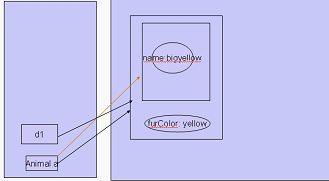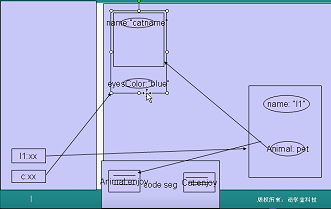1、继承中的构造方法
- 子类的构造过程必须调用父类的构造方法
- 子类可以在自己的构造方法中使用 super(argument_list)调用父类的构造方法
- 使用 this(argment_list) 调用本类的另外的构造方法
- 如果调用super,必须写在子类构造方法的第一行
- 如果子类的构造方法中没有显示的调用父类构造方法,则系统默认调用父类无参数的构造方法
- 如果子类构造方法中既没有显式调用父类构造方法,而父类中又没有无参的构造方法,则编译出错
1 class SuperClass { 2 private int n; 3 4 SuperClass() { 5 System.out.println("SuperClass"); 6 } 7 8 SuperClass(int n) { 9 System.out.println("SuperClass(" + n + ")");//先输出传入的参数 10 this.n = n;//再把参数赋值给成员变量 11 } 12 } 13 14 class SubClass extends SuperClass { 15 private int n; 16 17 SubClass() { 18 super(300); 19 System.out.println("SubClass"); 20 } 21 22 SubClass(int n) { 23 System.out.println("SubClass(" + n + ")"); 24 this.n = n; 25 } 26 } 27 28 public class Test { 29 public static void main(String[] args) { 30 SubClass sc1 = new SubClass(); 31 SubClass sc2 = new SubClass(400); 32 } 33 }
这个不太好分析:
1 class Person { 2 private String name; 3 private String location; 4 5 Person(String name) { 6 this.name = name; 7 location = "beijing"; 8 } 9 10 Person(String name, String location) { 11 this.name = name; 12 this.location = location; 13 } 14 15 public String info(){ 16 return "name = " + name + "location = " + location; 17 } 18 } 19 20 class Student extends Person { 21 private String school; 22 23 Student(String name, String school) { 24 this(name, "beijing",school);//调用的是Student(String n, String l, String school){}方法 25 } 26 27 Student(String n, String l, String school) { 28 super(n,l); 29 this.school = school; 30 } 31 public String info() { 32 return super.info() + "school" + school; 33 } 34 } 35 36 public class Test { 37 public static void main(String[] args) { 38 Person p1 = new Person("A"); 39 Person p2 = new Person("B","shanghai"); 40 Student s1 = new Student("C", "S1"); 41 Student s2 = new Student("C", "shanghai", "S2"); 42 43 System.out.println(p1.info()); 44 System.out.println(p2.info()); 45 System.out.println(s1.info()); 46 System.out.println(s2.info()); 47 } 48 }
2、Object类
- Object类是所有Java类的根基类
- 如果在类的声明中未使用extends关键字指明其父类则默认为Object类
- 在java.lang这个包下(特例:Java中只有使用java.lang中的方法可以不导入java.lang这个包,其他的必须导入包)
toString方法:
Object类中定义有public String toString()方法,其返回值是String类型,描述当前对象的相关信息
再进行String与其他类型数据的连接操作时(如:System.out.println("info" + Person)),将自动调用该对象类的toString()方法
可以根据需要在用户自定义类型中重写toString()方法
equals方法:
3、对象转型(对象转型调用的是属性,多态调用的是方法)
一个父类的引用类型变量可以“指向”子类的对象
一个父类的引用不可以访问其子类对象新增加的成员(属性和方法)
可以使用 引用 变量 instanceof 类名 来判断该引用型变量所“指向”的对象是否属于该类或该类的子类
子类的对象可以当作父类的对象来使用称作向上转型(upcasting),反之成为向下转型(downcasting)
对象转型1
1 //定义一种动物 2 class Animal { 3 public String name; 4 Animal(String name) { 5 this.name = name; 6 } 7 } 8 //猫继承了动物 9 class Cat extends Animal { 10 public String eyeColor; 11 Cat(String n, String e) { 12 super(n); 13 eyeColor = e; 14 } 15 } 16 //狗继承了动物 17 class Dog extends Animal { 18 public String furColor; 19 Dog(String n, String f) { 20 super(n); 21 furColor = f; 22 } 23 } 24 25 public class Test { 26 public static void main(String[] args) { 27 Animal a = new Animal("name"); 28 Cat c = new Cat("catname", "blue"); 29 Dog d = new Dog("dogname", "black"); 30 31 System.out.println(a instanceof Animal);//true,a是一种Animal 32 System.out.println(c instanceof Animal);//true,c是一种Animal 33 System.out.println(d instanceof Animal);//true,d是一种Animal 34 System.out.println(a instanceof Cat);//false ,Animal不是一种Cat 35 36 /* 39 Animal类型的a指向子类对象Dog,
a指向了Dog中Animal的name属性和Dog的furColor属性
但是a只能访问Dog自身的name属性,不能访问Dog自身的furColor属性
40 */ 41 a = new Dog("bigDog", "yellow"); 42 System.out.println(a.name);//bigDog 43 //System.out.println(a.eyeColor); errer 44 45 /* 46 a = new Dog后,a是一种Dog,只是不能访问子类特有的成员 47 */ 48 System.out.println(a instanceof Animal);//true 49 System.out.println(a instanceof Dog);//true 50 /* 51 要想访问子类特有的成员,需要强制类型转换 52 */ 53 Dog d1 = (Dog)a; 54 System.out.println(d1.furColor);//yellow 55 } 56 }

对象转型2
1 //定义一种动物 2 class Animal { 3 public String name; 4 Animal(String name) { 5 this.name = name; 6 } 7 } 8 //猫继承了动物 9 class Cat extends Animal { 10 public String eyeColor; 11 Cat(String n, String e) { 12 super(n); 13 eyeColor = e; 14 } 15 } 16 //狗继承了动物 17 class Dog extends Animal { 18 public String furColor; 19 Dog(String n, String f) { 20 super(n); 21 furColor = f; 22 } 23 } 24 25 public class Test { 26 public static void main(String[] args){ 27 Test test = new Test(); 28 Aniaml a = new Animal("name"); 29 Cat c = new Cat("catname", "blue"); 30 Dog d = new Dog("dogname", "black"); 31 test.f(a); 32 test.f(c); 33 test.f(d); 34 } 35 /* 36 37 38 父类引用指向子类对象,可扩展性比较好(但是还没有达到最好,最好是多态) 39 否则需要写三个f()方法f(Animal a)、 f(Cat a) 、f(Dog a) 40 才能调用有继承关系的Animal、Cat、Dog 41 42 */ 43 public void f(Animal a) { //父类引用指向子类对象 44 if(a instanceof Cat) { 45 Cat cat = (Cat) a; 46 System.out.println(" " + cat.eyesColor + " eyes"); 47 }else if(a instanceof Dog) { 48 Dog dog = (Dog) d; 49 System.out.println(" " + dog.eyesColor + " eyes"); 50 } 51 } 52 }
4、动态绑定和多态(可扩展性达到最好)
三个条件:
- 要有继承
- 要有重写
- 父类引用指向子类对象
动态绑定是指“在执行期间(而非编译期间)判断所引用对象的实际类型,根据实际的类型调用其相应的方法”
1 class Animal { 2 private String name; 3 Animal(String name) { 4 this.name = name; 5 } 6 public void enjoy(){ 7 System.out.println("叫声....."); 8 } 9 } 10 11 class Cat extends Animal { 12 private String eyeColor; 13 Cat(String name, String eyeColor) { 14 super(name); 15 this.eyeColor = eyeColor; 16 } 17 public void enjoy() { 18 System.out.println("猫叫声....."); 19 }; 20 } 21 22 class Dog extends Animal { 23 private String furColor; 24 Dog(String name, String furColor) { 25 super(name); 26 this.furColor = furColor; 27 } 28 public void enjoy() { 29 System.out.println("狗叫声....."); 30 }; 31 } 32 33 class Lady { 34 private String name; 35 private Animal pet; 36 Lady(String name, Animal pet) { 37 this.name = name; 38 this.pet = pet; 39 } 40 public void myPetEnjoy() { 41 pet.enjoy(); 42 } 43 } 44 45 public class Test { 46 public static void main(String[] args) { 47 Cat c = new Cat("catname", "blue"); 48 Dog d = new Dog("dogname", "black"); 49 50 Lady l1 = new Lady("l1", c); 51 Lady l2 = new Lady("l2", d); 52 53 l1.myPetEnjoy(); 54 l2.myPetEnjoy(); 55 } 56 }

程序中有3个enjoy方法,当你调用的时候调的哪一个是根据实际当中的类型来确定,而不是通过引用中的类型来确定(参考对象上面对象转型)
5、抽象类和方法
用abstract关键字来修饰一个类时,这个类叫做抽象类
用abstract关键字来修饰一个方法时,这个方法叫做抽象方法
含有抽象方法的类必须被声明为抽象类
抽象类必须被继承,抽象方法必须被实现
抽象类不能被实例化
抽象方法只需声明,不需要实现
6、final关键字
final的变量的值不能够被改变
- final的成员变量
- final的局部变量
final的方法不能被重写
final的类不能被继承
7、接口
接口是抽象方法和常量值的定义的集合
从本质上讲,接口是一种特殊的抽象类,这种抽象类只包含常量和方法的定义,而没有变量和方法的实现
接口定义举例:
public interface Runner { public static final int id = 1; public void start(); public void run(); public void stop(); }
接口特性:
接口可以多重实现
接口中声明的属性默认为public static final的,也只能是public static final的
接口中只能定义抽象方法,而且这些方法默认为public的,也只能是public的
接口可以继承其它的接口,并添加新的属性和抽象方法
多个无关的类可以实现同一接口
一个类可以实现多个无关的接口
与继承关系类似,接口与实现类之间存在多态性
1 interface Singer { 2 public void sing(); 3 public void sleep(); 4 } 5 6 interface Painter { 7 public void paint(); 8 public void eat(); 9 } 10 11 class Student implements Singer {//Student继承了Singer 12 private String name; 13 Student(String name) { 14 this.name = name; 15 } 16 public void study() { 17 System.out.println("studying"); 18 } 19 public String getName() { 20 return name; 21 } 22 public void sing() {//实现了sing方法 23 System.out.println("student is singing"); 24 } 25 public void sleep() {//实现了sleep方法 26 System.out.println("student is sleeping"); 27 } 28 } 29 30 class Teacher implements Singer, Painter {//Teacher继承了Singer、Painter 31 private String name; 32 public String getString() { 33 return name; 34 } 35 Teacher(String name) { 36 this.name = name; 37 } 38 public void teach() { 39 System.out.println("teaching"); 40 } 41 public void sing() {//Teacher继承了sing方法 42 System.out.println("teacher is singing"); 43 } 44 public void sleep() {//Teacher继承了sleep方法 45 System.out.println("teacher is sleep"); 46 } 47 public void paint() {//Teacher继承了paint方法 48 System.out.println("teacher is paint"); 49 } 50 public void eat() {//Teacher继承了eat方法 51 System.out.println("teacher is eat"); 52 } 53 } 54 55 public class Test { 56 public static void main(String[] args) { 57 Singer s1 = new Student("le"); 58 s1.sing(); 59 s1.sleep(); 60 Singer s2 = new Teacher("steven"); 61 s2.sing(); 62 s2.sleep(); 63 Painter p1 = (Painter) s2; 64 p1.paint(); 65 p1.eat(); 66 } 67 }
结果:
student is singing
student is sleeping
teacher is singing
teacher is sleep
teacher is paint
teacher is eat